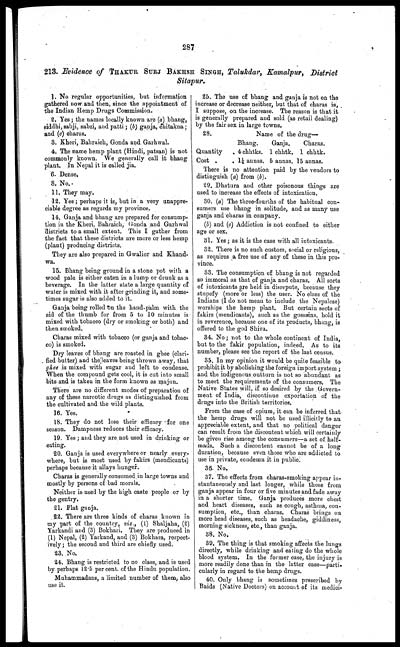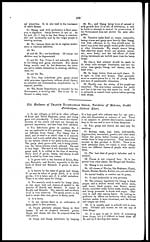Medicine - Drugs > Report of the Indian Hemp Drugs Commission, 1894-1895 > Volume V
(307) Page 287
Download files
Individual page:
Thumbnail gallery: Grid view | List view

287
213. Evidence of THAKUR SURJ BAKHSH SINGH, Talukdar, Kamalpur, District
Sitapur.
1. No regular opportunities, but information
gathered now and then, since the appointment of
the Indian Hemp Drugs Commission.
2. Yes; the names locally known are (a) bhang,
siddhi, sabji, sabzi, and patti ; (b) ganja, chitakna ;
and (c) charas.
3. Kheri, Bahraich, Gonda and Garhwal.
4. The name hemp plant (Hindi, patsan) is not
commonly known. We generally call it bhang
plant. In Nepal it is called jia.
6. Dense.
8. No.
11. They may.
12. Yes; perhaps it is, but in a very unappre-
ciable degree as regards my province.
14. Ganja and bhang are prepared for consump-
tion in the Kheri. Bahraich, Gonda and Garhwal
districts to a small extent. This I gather from
the fact that these districts are more or less hemp
(plant) producing districts.
They are also prepared in Gwalior and Khand-
wa.
15. Bhang being ground in a stone pot with a
wood pale is either eaten in a lump or drunk as a
beverage. In the latter state a large quantity of
water is mixed with it after grinding it, and some-
times sugar is also added to it.
Ganja being rolled on the hand-palm with the
aid of the thumb for from 5 to 10 minutes is
mixed with tobacco (dry or smoking or both) and
then smoked.
Charas mixed with tobacco (or ganja and tobac-
co) is smoked.
Dry leaves of bhang are roasted in ghee (clari-
fied butter) and the leaves being thrown away, that
ghee is mixed with sugar and left to condense.
When the compound gets cool, it is cut into small
bits and is taken in the form known as majun.
There are no different modes of preparation of
any of these narcotic drugs as distinguished from
the cultivated and the wild plants.
16. Yes.
18. They do not lose their efficacy for one
season. Dampness reduces their efficacy.
19. Yes; and they are not used in drinking or
eating.
20. Ganja is used everywhere or nearly every-
where, but is most used by fakirs (mendicants)
perhaps because it allays hunger.
Charas is generally consumed in large towns and
mostly by persons of bad morals.
Neither is used by the high caste people or by
the gentry.
21. Flat ganja.
22. There are three kinds of charas known in
my part of the country, viz., (1) Shaljaha, (2)
Yarkandi and (3) Bokhari. They are produced in
(1) Nepal, (2) Yarkand, and (3) Bokhara, respect-
ively; the second and third are chiefly used.
23. No.
24. Bhang is restricted to no class, and is used
by perhaps 12.5 per cent. of the Hindu population.
Muhammadans, a limited number of them, also
use it.
25. The use of bhang and ganja is not on the
increase or decrease neither, but that of charas is,
I suppose, on the increase. The reason is that it
is generally prepared and sold (as retail dealing)
by the fair sex in large towns.
|
28. |
Name of the drug— |
||
|
Bhang. |
Ganja. |
Charas. |
|
|
Quantity |
. 4 chhtks. |
1 chhtk. |
1 chhtk. |
|
Cost . |
. 1¼ annas. |
5 annas. |
15 annas. |
There is no attention paid by the vendors to
distinguish (a) from (b).
29. Dhatura and other poisonous things are
used to increase the effects of intoxication.
30. (a) The three-fourths of the habitual con-
sumers use bhang in solitude, and as many use
ganja and charas in company.
(b) and (c) Addiction is not confined to either
age or sex.
31. Yes; as it is the case with all intoxicants.
32. There is no such custom, social or religious,
as requires a free use of any of these in this pro-
vince.
33. The consumption of bhang is not regarded
so immoral as that of ganja and charas. All sorts
of intoxicants are held in disrepute, because they
stupefy (more or less) the user. No class of the
Indians (I do not mean to include the Nepalese)
worships the hemp plant. But certain sects of
fakirs (mendicants), such as the gossains, hold it
in reverence, because one of its products, bhang, is
offered to the god Shiva.
34. No; not to the whole continent of India,
but to the fakir population, indeed. As to its
number, please see the report of the last census.
35. In my opinion it would be quite feasible to
prohibit it by abolishing the foreign import system ;
and the indigenous outturn is not so abundant as
to meet the requirements of the consumers. The
Native States will, if so desired by the Govern-
ment of India, discontinue exportation of the
drugs into the British territories.
From the case of opium, it can be inferred that
the hemp drugs will not be used illicitly to an
appreciable extent, and that no political danger
can result from the discontent which will certainly
be given rise among the consumers—a set of half-
mads. Such a discontent cannot be of a long
duration, because even those who are addicted to
use in private, condemn it in public.
36. No.
37. The effects from charas-smoking appear in-
stantaneously and last longer, while those from
ganja appear in four or five minutes and fade away
in a shorter time. Ganja produces more chest
and heart diseases, such as cough, asthma, con-
sumption, etc., than charas. Charas brings on
more head diseases, such as headache, giddiness,
morning sickness, etc., than ganja.
38. No.
39. The thing is that smoking affects the lungs
directly, while drinking and eating do the whole
blood system. In the former case, the injury is
more readily done than in the latter case—parti-
cularly in regard to the hemp drugs.
40. Only bhang is sometimes prescribed by
Baids (Native Doctors) on account of its medici-
Set display mode to: Large image | Zoom image | Transcription
Images and transcriptions on this page, including medium image downloads, may be used under the Creative Commons Attribution 4.0 International Licence unless otherwise stated. ![]()
| India Papers > Medicine - Drugs > Report of the Indian Hemp Drugs Commission, 1894-1895 > Volume V > (307) Page 287 |
|---|
| Permanent URL | https://digital.nls.uk/75121746 |
|---|
| Description | Volume 5: Evidence of witnesses from North-Western Provinces and Oudh and Punjab. Answers from witnesses in North-Western Provinces, Oudh and Punjab about cultivation and growth of hemp, preparation or manufacture, trade, consumption or use, effects, administration - taxation and control. |
|---|---|
| Attribution and copyright: |
|




